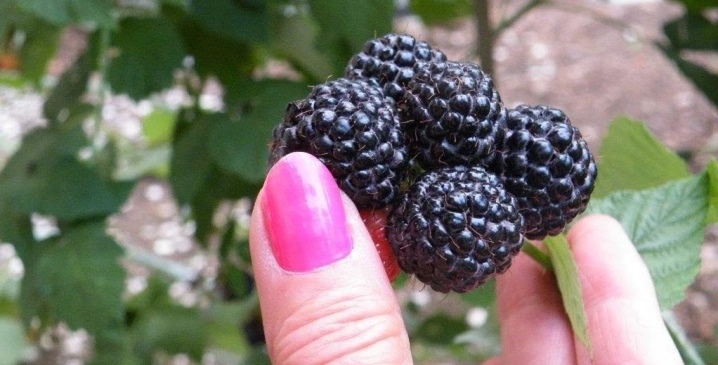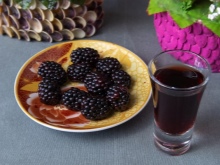What berries are similar to blackberries?

There are many berries and shrubs that look very similar to blackberries: they have the same bluish-black color, shape, size, and sometimes flowers. All of this is often misleading and confusing to people. In this article, we will analyze in detail which berries are similar to blackberries and how they differ from it.


Black Raspberry Review
Cumberland
A fairly old variety of berries that was bred towards the end of the 19th century by Miller in America. It spread very quickly across European territories. At the present time, Cumberland is often found in the gardens of our country, which is explained by its frost resistance: the bush of this plant can even withstand temperatures of -30 degrees.
The bush itself, as a rule, grows powerful and has long shoots on which thorns are located. It grows like a half-creeping blackberry: at first, its shoots are erect, but, having begun to grow, they bend in an arc. In addition, the plant has the ability to "move" around the site, as its tops, touching the ground, take root.


If we talk about the fruits of Cumberland, then they do not differ in large size, and the fertility of the plant can hardly be called high. A distinctive feature of its berries can be considered a high density, which allows them to be stored for a long time and to transfer transportation without problems.
This variety has other features that distinguish it from blackberries. So, in the autumn period, Cumberland looks very decorative: its shoots become gray-blue, which looks exotic and beautiful. It is for this reason that this plant is often used to create hedges. Such a hedge will not only look beautiful, but also become good, and most importantly, reliable protection for your site - this will be facilitated by numerous thorns, which will be very difficult to climb through.

Ember
And this mid-early variety was bred by Russian scientists from Siberia relatively recently, but has already become widespread.
It is especially recommended to grow on lands that stretch from the Urals to the Far East.
This variety is frost-resistant and is able to withstand various diseases, which is why many prefer it.
Raspberry Ember, unlike the already mentioned Cumberland, is distinguished by the smaller size of its bush. There are significantly fewer thorns in the shoots of such a plant, but the shoots themselves can be attributed to the semi-creeping type. They are usually around 230 centimeters long. The color of such lashes, if they are annual, is green, with a bluish bloom. Biennial lashes have a brownish tint.


If we talk about the fruits of this variety, then they do not differ in large size. As a rule, their weight barely reaches 2 grams.
But the fertility of the bush is quite good, especially if favorable conditions for growth and development are provided to it. So, one shrub is able to give about 8 kilograms of berries.
By the way, black raspberries have other features as well. So, berries are completely unattractive to birds. Usually birds flock to fruits of bright shades: yellow or red. They ignore black berries.

Description of mulberry
Mulberry is a well-known long black or white berry that resembles a blackberry in its appearance to many. This berry is the fruit of a perennial mulberry tree, which, growing naturally, can grow up to 20 meters, has several thick trunks and can bear fruit for up to 200 years. In artificial conditions, the tree reaches no more than 4 meters. At the same time, mulberry grows exclusively in the southern regions, where a warm climate prevails. In our country, it can often be found in the North Caucasus and the Lower Volga region. Sometimes the plant can be seen in the middle lane, and often it is growing wild.


Many people call Mulberry only "tyutina" or "mulberry", the reason for which is the tree on which they grow.
Black mulberry is similar to blackberry only in berries. The similarities only affect the shape and color of the fruit. Otherwise, they are completely different. Mulberry has a lot of peculiarities: its berries are usually long, about 5.5 centimeters, very sweet, have an unusual smell, and after them a strange aftertaste remains. Blackberries, on the other hand, tend to be more acidic. In addition, they grow on a bush, and not on a tree, like Mulberry. That is why it is simply impossible to confuse these two plants.
Moreover, mulberry berries are actively used in folk medicine. They help cure diseases such as sore throat and stomatitis.
Mulberry leaves are also useful: a tincture made from them can lower blood pressure.



There is another variety of this Mulberry, which is called Darkie. It is more suitable for the climate of the central part of the country. This is due to the fact that the plant has a high degree of adaptation to low temperatures and short summer. In addition, the Dark-haired woman is prone to escape, which allows her to quickly recover if her shoots are frozen.
However, if the frosts are excessively severe and last for a long time, then this can still significantly affect the yield of the plant, and not in the best way - because of this, the Darkie must be protected with a shelter.
If we talk about the berries of this variety, then they, as a rule, are about 3 centimeters long, ripen early and have a pleasant sour taste. You can try them already in June.

Other berries
Blackberries can be confused with other berries. Some of them are poisonous and pose a danger to humans.
So, a perennial plant called Lakonos is poisonous. It has American roots and is rarely found in our latitudes. The plant itself bears little resemblance to a blackberry: it has thick stems that can reach up to 150 centimeters in height, and by the end of spring it has erect peduncles with green-pink flowers that outwardly resemble hyacinth. Compound fruits of Lakonos look very exotic, they have segmented black fruits, which are located on elongated "ears". So they just have similarities with blackberries.


Lakonos berries ripen by the end of August. During this period, fertility changes its color to reddish. Against the background of this shade, small black fruits look very catchy and spectacular, which attracts the attention of many.
However, eating such berries is highly discouraged, especially when it comes to young children and pregnant women. Others, too, should not feast on the fruits of Lakonos, as they can cause severe heart rhythm disturbances.

It is interesting that, despite its toxicity, this plant is often used in folk medicine, and both the fruits of the Lakonos and its roots are involved. The latter especially help to cope with rheumatism. However, the selection of roots for creating a medicine must be approached carefully, paying close attention to the color of the fracture.
For medicinal purposes, it is allowed to use exclusively white roots. If a red color is visible on their fracture, then such roots are not recommended to be used for medicine.



There are other berries that are similar to blackberries. For example, ezhemalina, which is now especially common in summer cottages. The most popular are the following varieties of Yezhemalina: Loganberry, Michurinsky Progress and Tayberry. However, they all do not differ much from blackberries, since they are the product of hybridization.














The comment was sent successfully.